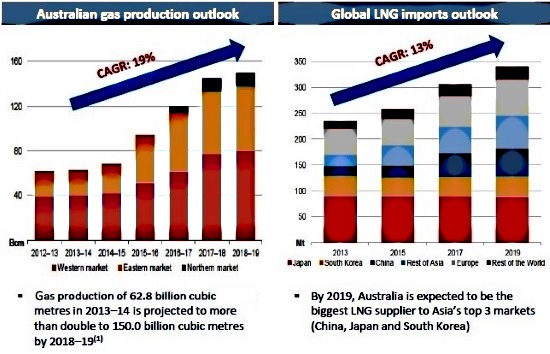About half of Otto Marine's fleet is deployed in Australia, a market where chartering demand is relatively stable due to the LNG production projects there.
 Source: Australia Bureau of Resources and Energy Economics, Sep 2014
Source: Australia Bureau of Resources and Energy Economics, Sep 2014
Another 4 vessels are deployed in North Sea, where few Asian players have successfully ventured because vessels deployed in the North Sea are larger and require DNV classification.
Thirteen vessels are deployed in Africa and Mexico. The Group has been chartering vessels to these two regions since 5 years ago. It enjoys high utilization rates in these two regions, thanks to a strong relationship with local partners.
Vessel ownership versus 3rd party vessels
Another reason the Group is able to improve its vessel utilisation rate under a challenging chartering environment is the ability to maintain a prudent balance between vessel ownership and the use of third-party vessels. During the past 2 months, the Group returned about 8 vessels to ship-owners. Two new vessels were chartered for back-to-back contracts from an oil major.
“We currently own less than 50% of our fleet and intend to increase the proportion of vessels owned to no more than 85%," said Mr See. “Even though third party vessels generate lower margin, they provide the flexibility of returning vessels to ship-owners when charter demand falls." The Group’s strategy is to replace older vessels with new vessels with more advanced technology.
Current levels of vessel market values provide opportunity to buy vessels at competitive rates. Recently, it bought a 4-year old 16,000 bhp AHTS built in Italy (Go Spica). This vessel is currently on a long term charter contract with an international oil major in Australia. It also bought a brand new 16,000 bhp AHTS that was built in Japan. This vessel is also on a long term charter contract.
Dealing with oil price crunch
The Group generated gross profit of US$8 million from its shipyard in 1QFY2015, before extraordinary gain from vessel disposal.
Its subsea services segment generated gross profit of US$2.2 million. However, challenging conditions in shipping and chartering resulted a net loss of US$13.3 million for 1QFY2015 as the oil price crunch had put much pressure on national and international oil majors to negotiate for lower vessel charter rates.







